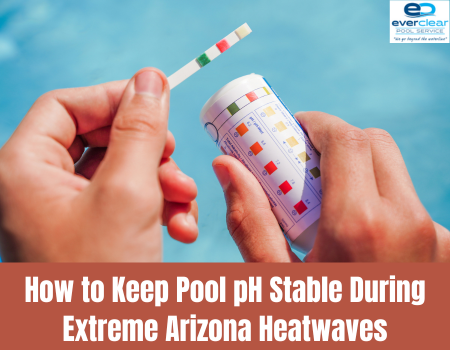 Arizona summers are legendary; the kind of heat that can fry an egg on the sidewalk and turn a backyard pool into a warm bath. But while most people think of swimming pools as a refuge from scorching temperatures, pool owners know that extreme heat can wreak havoc on water chemistry. Maintaining a stable pool pH balance in a hot climate like Arizona isn’t just about crystal-clear water; it’s about protecting your equipment, ensuring swimmer comfort, and preventing expensive maintenance problems.
Arizona summers are legendary; the kind of heat that can fry an egg on the sidewalk and turn a backyard pool into a warm bath. But while most people think of swimming pools as a refuge from scorching temperatures, pool owners know that extreme heat can wreak havoc on water chemistry. Maintaining a stable pool pH balance in a hot climate like Arizona isn’t just about crystal-clear water; it’s about protecting your equipment, ensuring swimmer comfort, and preventing expensive maintenance problems.
Let’s explore how desert heat affects pool chemistry and what real, science-based strategies you can use to keep your water balanced, especially in places like Phoenix, Tucson, or Lake Havasu, where summer highs often climb well past 110°F.
How Heat Disrupts Pool pH
In simple chemistry terms, pH measures how acidic or basic your pool water is, on a scale from 0 to 14. The ideal range for swimming pools sits between 7.4 and 7.6, slightly basic to match the natural pH of human eyes and skin.
However, under extreme desert heat, several factors can cause pH levels to fluctuate dramatically:
- Increased Evaporation:
As water evaporates under the Arizona sun, the concentration of dissolved minerals (like calcium and alkalinity) rises. This can push the pH higher, creating scaling and cloudy water. - Higher Water Temperature:
Warm water accelerates chemical reactions. Chlorine dissipates faster, carbon dioxide escapes more readily, and pH levels climb as a result. - Intense Sunlight:
UV rays break down chlorine molecules, especially if stabilizers like cyanuric acid (CYA) are low. When chlorine breaks down, its ability to manage pH-altering contaminants decreases, leading to instability. - Dust and Organic Debris:
Arizona’s monsoon winds and desert dust can dump organic materials into your pool. As they decompose, they release acids that temporarily lower pool pH, only for it to rise again when chlorine oxidizes them.
This constant push-and-pull makes desert pool maintenance more chemistry-intensive than in cooler regions.
Chemistry-Backed Strategies to Keep Pool pH Stable
Managing pool chemistry in extreme heat is all about balance, not overcorrecting, but anticipating shifts and adjusting gradually. Here are key strategies proven to work in hot, arid regions like Lake Havasu and Phoenix:
1. Keep Alkalinity in the Right Range
Total alkalinity (TA) functions like a buffer for pH. If it’s too low (below 80 ppm), pool pH will swing wildly; if it’s too high (above 120 ppm), pH will tend to creep up constantly.
- Ideal range: 80–100 ppm for Arizona pools.
Use baking soda (sodium bicarbonate) to raise alkalinity and muriatic acid to lower it. Test at least twice weekly during heatwaves.
2. Control Evaporation with Shade and Covers
Evaporation doesn’t just waste water, it concentrates minerals that drive up pH. Using solar covers, shade sails, or pergolas over parts of your pool helps slow down evaporation and stabilizes chemical balance.
For Lake Havasu pool care, where evaporation rates can exceed 100 inches per year, even partial shading can make a huge difference.
3. Monitor and Adjust pH More Frequently
In cooler months, testing twice a week might suffice. But in 110°F heat, pH levels can swing in 24 hours. Use a digital pool pH tester or reliable drop kit daily during extreme temperatures.
If pH exceeds 7.8, add small, measured doses of acid instead of dumping large amounts. Slow adjustments maintain equilibrium better.
4. Maintain Proper Calcium Hardness
In desert regions, fill water tends to have high calcium content, which contributes to scaling when pH is high. Keep calcium hardness between 200–400 ppm and use sequestrants if scaling starts forming on tile lines.
5. Use Stabilized Chlorine and CYA Properly
Cyanuric acid (CYA) shields chlorine from UV degradation. But too much (above 60 ppm) can lock up chlorine, preventing it from sanitizing effectively, which in turn affects pH balance.
Aim for 30–50 ppm CYA, especially for outdoor pools in full sun.
6. Add Aeration Only When Necessary
While aeration (like water features or fountains) can help cool pool water, it also raises pH by driving carbon dioxide out of the water. During heatwaves, reduce aeration time or run fountains at night when temperatures drop.
7. Shock at Night
High heat and sunlight neutralize chlorine quickly. Always shock your pool after sunset so the chlorine has time to work overnight without being destroyed by UV exposure. This not only maintains sanitation but also helps balance pH naturally.
Proactive Maintenance Pays Off
Extreme heat can make pool chemistry feel like a constant battle, but consistency wins. The key is staying ahead of pH swings rather than reacting to them after they happen. Here’s a simple weekly desert pool maintenance checklist:
- Test pH, alkalinity, and chlorine daily during heatwaves.
- Adjust in small increments — never all at once.
- Rinse pool filters and skimmers to reduce organic buildup.
- Use a stabilizer and maintain CYA at proper levels.
- Check evaporation loss and refill with balanced water if necessary.
By following a commercial-style maintenance rhythm even for residential pools, Arizona homeowners can enjoy clean, balanced water all summer, without the constant cloudiness, scaling, or eye irritation that comes with unstable chemistry.
Maintaining pool pH balance in a hot climate like Arizona’s isn’t just about beauty, it’s chemistry in action. When water temperatures rise, reactions speed up, and every chemical interacts differently.
But with consistent testing, mindful adjustments, and protective measures like shade and stabilizers, your pool can stay clear, balanced, and refreshing even through the most intense desert heat.
